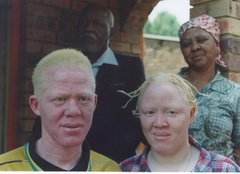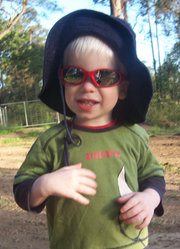Last spring, a zebra born in Africa's Nairobi National Park caused quite a stir. That's because the newborn foal was stripeless. Unlike others in its herd, the knobby-kneed newborn had pink eyes and an all-white body--a sure sign it was an albino.
What caused the milky hue? Usually, plants and animals get their distinctive coloring from pigments, or colored chemical compounds that absorb light. Before birth, an organism's genes (units of hereditary material) normally direct its cells to produce these pigments. But Nairobi's newest zebra--and most other albino animals, including humans--lacks these color-coding genes. The result? An unusual phenotype (FEE-no-type, physical appearance): Their skin, fur or hair, and eyes are mostly color-free. For wild animals, this rare trait (characteristic determined by an organism's genes) spells trouble.
RARE BREED
"The odds of a human being born with the characteristics of albinism are only about one in 20,000," says Dr. Rick Thompson, an eye doctor and chair of the board of scientific advisers for the National Organization for Albinism and Hypopigmentation (HIGH-po-pig-men-TAY-shun). That's because the gene that controls for pigmentation has two alleles (uh-LEELZ, forms of agene)--one for coloration, and one for albinism. Humans and other animals have two copies of most genes, one copy from each parent. The allele for albinism is recessive. That means an organism will be color-free only if both copies of the pigment gene have the albinism allele. That can happen even if neither parent shows signs of albinism. How? Both parents must be carriers, or have at least one copy of the albinism allele and pass it on to the offspring (see Nuts & Bolts, p. 10). If only one parent passes on the albinism allele, the offspring will have typical pigmentation, says Thompson.
The odds of a wild animal--such as the African zebra--being born with albinism are even lower than those of a human. Why? Few albinos born in the wild survive long enough to breed. Everyday tasks carry hidden dangers for the color-free. Hungry predators (animals that hunt and kill other animals for food) easily spot the pale creatures in their natural habitats and gobble them up. The animals can also fall victim to sun-related diseases.
SIGHT SEEN
For animals trying to hide from predators, albinism can be a dangerous trait. A white-as-cotton squirrel, for instance, doesn't stand a chance of blending in with a tree trunk. Often, survival means spying an enemy first and making a quick getaway. But even that can be tough for albino animals: Lack of pigmentation leads to abnormal development of their eyes and poor vision for details. The good news? "Animals in the wild rely on peripheral vision to spot movement. And that remains intact," says Thompson.
When animals aren't hiding from danger, they're often darting about in search of food or basking in the midday sun. But even the sun can be an enemy to albino animals.
DEADLY RAYS
The sun's hazardous ultraviolet (UV) radiation (invisible energy waves) bombards an animal's skin. For most creatures, sunbeams signal their bodies to pump up the production of melanin (pigment that controls color). This natural toner helps skin tan rather than burn. Since albino animals can't produce pigments, they're unable to protect their skin. Too much UV exposure can spell severe sunburn--and possibly deadly cancers.
Albino reptiles (classification of animals that includes snakes, lizards, alligators, crocodiles, and turtles) face a particularly serious dilemma. These cold-blooded animals depend on external heat to regulate their body temperature and metabolism (process in which billions of the body's cells release energy stored in food). Reptiles' heat source: the sun.
When wild albino reptiles seek out the sun for warmth, they're in for trouble, says John Brueggen, a herpetologist (reptile scientist) at the Saint Augustine Alligator Farm in Florida. "They burn," he says. "But they don't know they're burning. So they'll keep bunting until they blister."
HELP FROM HUMANS
Does that mean all albinos are destined for a life in the shade? Not if humans can help it. Herpetologists like Brueggen pamper captive albino reptiles by placing slabs of heated stones in the animals' sunless habitats. The hot rocks allow the reptiles to heat up without UV exposure.
In the 1980s. researchers invented UV-blocking skin lotions for humans. While sunscreen can't save wild albino animals, it can help those in captivity: When an albino kangaroo at the San Francisco Zoo was a baby, zookeepers applied regular doses of sunscreen to the roo's pigment-free pink ears and nose until thick, adult fur grew in to provide a more natural shield.
NATURE'S WAY
So what's an albino animal without access to sunscreen lotions or warm rock slabs to do? With so many dangers stacked up against wild albinos. it's tempting to try to protect them. But park rangers say, "Hands off."
Charles Ooro, a wildlife-service officer at the Nairobi National Park, is doing just that with the albino zebra born last spring. He says, "[The zebra] seems to be doing fine. So we will allow it to stay in the wild to lead a normal and natural life--at least for the time being."
Nuts & Bolts
A chart called a Punnett square can help you determine the odds that an offspring will have a certain trait. Here's how:
1) Given each parent's genetic makeup, assign a lowercase letter for a recessive allele and an uppercase letter for a dominant allele (one that expresses itself even if the offspring inherits that allele from only one parent).
2) Put one parent's letter pair across the square's top, and the other along the left.
3) Cross, or match the top and left letters, to fill in the inner squares. These show the offspring's possible allele pairs.
[ILLUSTRATION OMITTED]
DID YOU KNOW?
* Albinism in plants is lethal. That's because albino plants are missing the pigment called chlorophyll. This chemical helps plants use the sun's energy to grow. Albino plants seldom survive more than a few days.
CRITICAL THINKING:
* If you were a wildlife service officer and you spotted an albino animal in the wild, would you catch it, and care for it in a protected area, or let it live its natural life? Discuss your answer and reasoning with the class.
CROSS-CURRICULAR CONNECTIONS:
SOCIAL STUDIES: Read about The Story of the Weeping Camel, a National Geographic film about how a rare white camel calf in Mongolia was rejected by its mother. Then, write a short story about a day in the life of a camel in Mongolia, from the camel's point of view. To read about the film, and Mongolia, visit: www.nationalgeographic.com/weepingcamel/index.html
RESOURCES
* Grolier search term: genetics
* Albino Animals, by Kelly Milner Halls, Darby Creek Publishing, 2004.
* Learn more about albinism at this kid-friendly site: http://kids health.org/health_problems/skin/albinism.html
CHECK FOR UNDERSTANDING
A WORLD WITHOUT COLOR
Name: --
DIRECTIONS: On a separate piece of paper, answer the following in complete sentences.
1. Define the following terms:
Pigments: --
Phenotype: --
Genes: --
Traits: --
2. Name two factors that make wild albino animals more vulnerable to predators than pigmented animals are.
3. Why is the sun harmful to albino animals? And why is it particularly harmful to amphibians?
ANSWERS
Name: --
1. Pigments are colored chemical compounds that absorb light.
Phenotype means physical appearance.
Genes are units of hereditary material.
Traits are characteristics determined by an organism's genes.
2. Wild albino animals are vulnerable to predators because their pale bodies make them easy to spot. Also, a lack of pigmentation leads to abnormal eye development, resulting in poor detailed vision. So it may be tough to spot motionless predators waiting to pounce.
3. Since albino animals can't produce pigments, they're unable to protect their skin from UV exposure, leading to severe sunburn--even cancer. Amphibians are cold-blooded animals. They depend on external heat to regulate their body temperature and metabolism. When wild albino reptiles seek out the sun for warmth, they burn and blister without knowing it.
Hands-ON SCIENCE (NO LAB REQUIRED)
After reading "A World Without Color" (p. 8), try this hands-on experiment to learn more about genes.
PREDICT
Traits are characteristics that are determined by an organism's genes, or units of hereditary information. Which traits do you think are caused by recessive genes (form of a gene that is expressed as a trait only if two genes--one inherited from each parent--are of the same form): earlobes that are attached (connected to the head), a widow's peak (hairline makes a V-shape at the top of your forehead), or the ability to curl your tongue into a U-shape? Would you expect a greater number of people in your class to have each of these traits, or not have them? For those with these traits, do you think their parents also have them?
YOU NEED
graph and plain paper * pencil
PROCEDURE
1. Before performing this experiment in class, survey your parents to find out whether or not they have the following traits: attached earlobes, a widow's peak, and tongue-curling ability. Record your findings on a data table (see Tracking Traits, right).
2. Then, determine which, if any, of the three traits you have. Add this information to your data table.
3. In class, your teacher will record on the chalkboard the number of students who show each trait, and whether both of the student's parents, just one, or neither parent also express that trait.
4. Using the data on the chalkboard. construct a bar graph showing the number of students who have each of the three traits. (Hint: The x-axis will list each trait, and the y-axis will show the number of students.)
CONCLUSIONS
1. Which trait is least abundant among students in your class? Explain.
2. For the least abundant trait, calculate the percentage of your classmates who showed it. Example: If 10 out of 50 students could roll their tongues. divide 50 into 10 and multiply by 100.
TAKE IT FURTHER
Research to learn more about your genes. A helpful site: http://student.biology.arizona.edu /sciconn/heredity/worksheet_ heredity.html
Earlobes
COPYRIGHT 2004 Scholastic, Inc.
COPYRIGHT 2005 Gale Group




